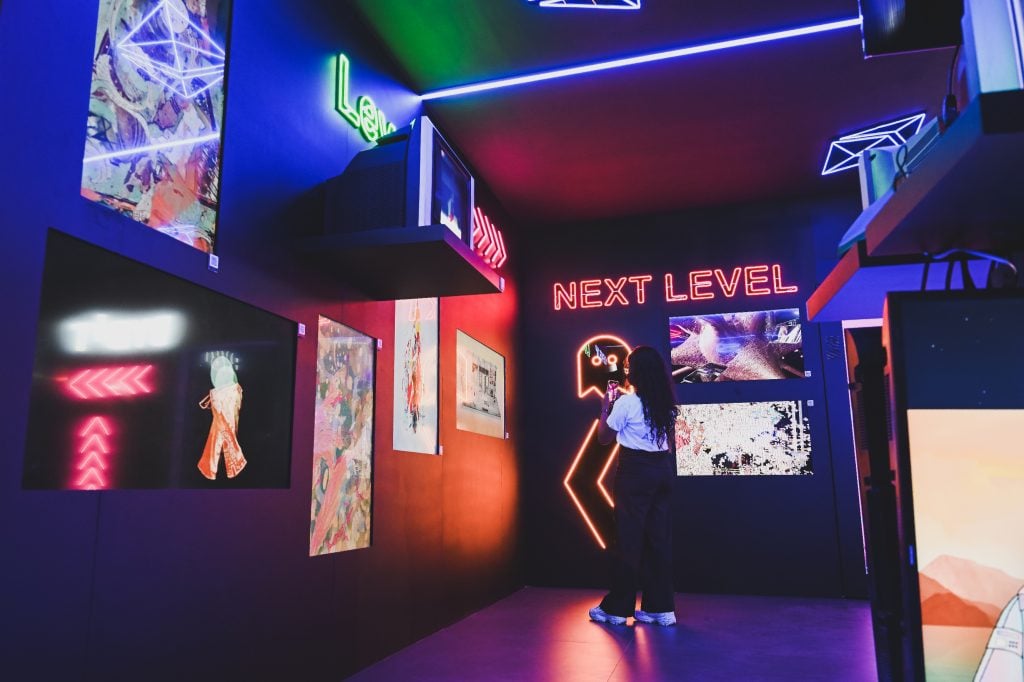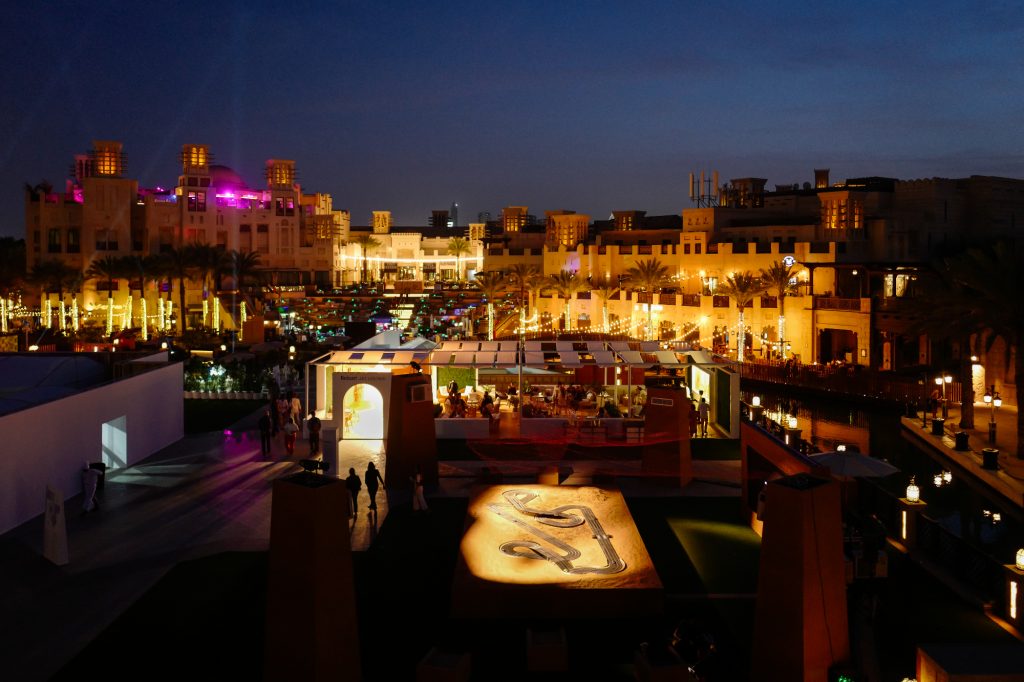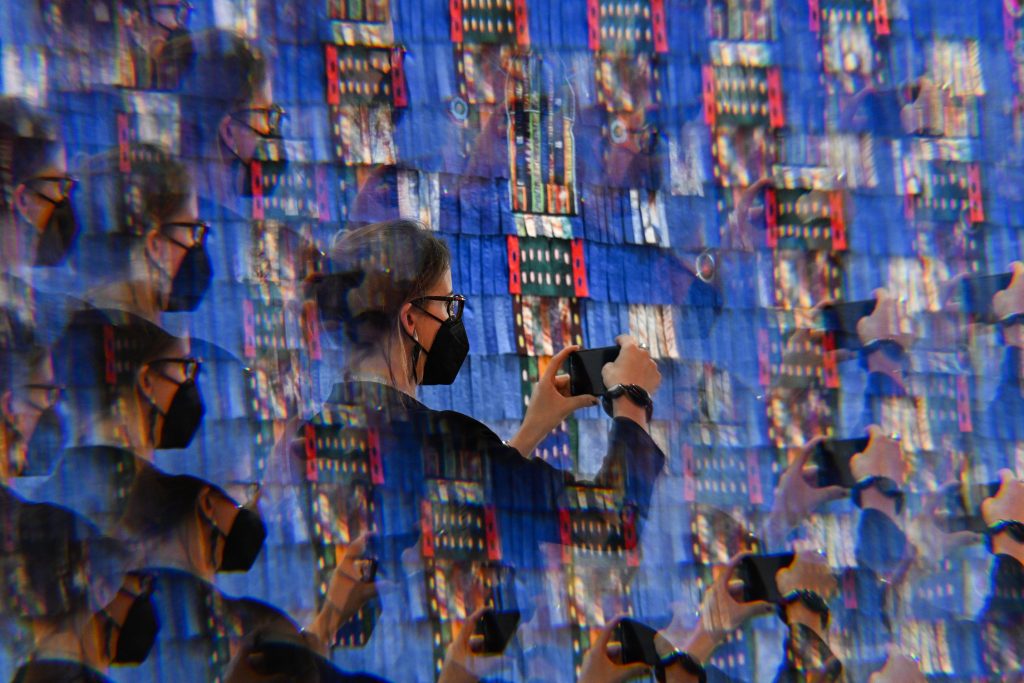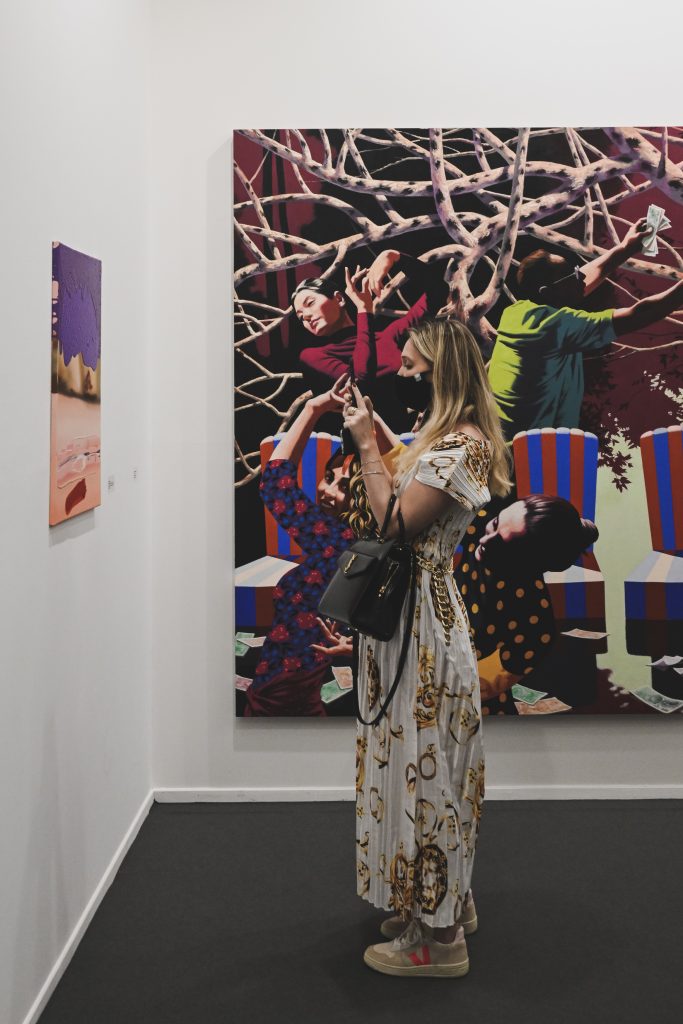Artnet News Pro
The UAE Wants to Become the Cryptocurrency Capital of the World. Here’s How Art Dubai Is Trying to Help
The fair's 15th edition includes several NFT projects and digital presentations.

The fair's 15th edition includes several NFT projects and digital presentations.

Rebecca Anne Proctor

Despite the grim state of world affairs, with a worsening war between Russia and Ukraine dominating headlines and attention spans, the ambiance at Art Dubai’s 15th edition (until March 13) was enthusiastic and hopeful.
One could hear an array of languages being spoken in the aisles of the fair’s sleekly devised setup, which took place this year at Art Dubai’s longtime home in Madinat Jumeirah. Visitors from around the Arab world, South Asia, China, the US, Iran, Africa, Europe, and Israel—whose citizens are now welcome in the UAE following the signing of the Abraham Accords in September 2020—came out to play, network, and buy art.
There was also plenty of Russian to be heard, which is unsurprising, as the UAE is home to 40,000 Russians, many of them bankers and financiers from Moscow who rushed to exit and escape to the Gulf. The UAE, in particular, is a seeming safe haven as the US, UK and EU toughen sanctions on Russia. (The UAE abstained on a UN Security Council vote condemning the Russian invasion of Ukraine.)

Installation view of Rele Gallery at Art Dubai, 2022. (Photo: Cedric Ribeiro/Getty Images for Art Dubai.)
Yet more than anything, the fair is an event for the non-West, and this year’s edition, the largest in the fair’s history, includes 104 galleries from over 40 countries, including 30 first-time participants, marking a vast leap from last year’s scaled-back edition of 50 galleries.
“We have been fighting for years to become a leader for the Global South and with this fair, it is now a reality,” Pablo del Val, Art Dubai’s international director told Artnet News. “I think Art Dubai is the least Western art fair that exists, and the energies and dialogues you see makes it more unique than ever.”
Among the African contingent was Rele Gallery from Nigeria, which presented a solo booth of paintings by Nigerian artist Anthonia Chinasa Nneji of self-portraits examining the relationship between women, religion, health, and society in Nigeria. During the preview, three works sold for $18,000 each, the gallery said.
Gallery 1957 from Accra, Ghana, returning to the fair, presented a solo booth of works by Nigerian artist Modupeola Fadugba, who was also the subject of the gallery’s 2018 booth. On the third day, the gallery said it sold nearly every work by the artist in its booth, with prices ranging from $35,000 to $52,000.
Loft Art Gallery from Casablanca, coming back to the event after a seven-year absence, presented works mostly by Moroccan artists, including the revered late painter Mohamed Melehi, photographer Mous Lamrabat, and Marion Boehm. The least expensive works sold for $7,000.

Art Dubai 2022. (Photo by Cedric Ribeiro_Getty Images for Art Dubai).
“I really liked the fact that there was a merging of various cultures, how Indian galleries were showing international art and even Pakistani art,” Rakesh Kumar, an Indian collector who lives between India and the UAE, told Artnet News. “There are no borders at these art galleries.”
He told Artnet News he bought works by Indian artists Vipeksha Gupta, Shailee Mehta, and Soumya Sanker Bose; and Emirati artists Kamrooz Aram, Hassan Sharif, and Mohammed Ahmed Ibrahim, all in the range of $4,500 to $50,000.
But Western galleries weren’t entirely absent. Among them was the global heavyweight Perrotin.
“We are very excited to return to Art Dubai this year, especially because we have just announced a new gallery in Dubai for 2022,” Emmanuel Perrotin told Artnet News. Dubai will now be the location of his ninth international gallery.
“Dubai is six hours by plane from two-thirds of the world’s population, and a highly dynamic city that is attracting a new audience,” Perrotin said. “We are always keen to bring our artists’ voices to audiences who do not always have the opportunity to engage with their work. The whole region is developing projects around art, and we want our artists to be able to participate in them.”
During the VIP preview, the gallery said, it sold works by Izumi Kato, Lee Bae, Jean Philippe Delhomme, Xiyao Wang, Xavier Veilhan, and two works by Daniel Arsham. Prices ranged from $13,200 to $82,500.
Beirut-based dealer Saleh Barakat, a longtime participant who’s presenting modern and contemporary Lebanese artists, remarked that the fair was more international than ever.
“We are highly satisfied, and sold works to buyers from the UAE, Lebanon, Belgians, and Americans,” he told Artnet News. “This is a fair that brings the Middle East together. Usually, we sell to more Arabs, but not this time. Dubai has become really cosmopolitan.”

Art Dubai 2022. (Photo by Cedric Ribeiro_Getty Images for Art Dubai).
Dubai is quickly becoming a global capital for cryptocurrency, a fact reflected in the fair’s newest section, Art Dubai Digital, which focuses on the long history of digital art from the 1980s to the present explosion of NFTs.
The section includes galleries and NFT platforms from around the world, such as Institut, Postmasters, Dastan x NFTation, and Bright Moments, and was the site of throngs of crowds over the course of the fair. it was also the home for the Global Art Forum, dedicated this year to examining crypto economies and digital artifacts.
“The UAE, and Dubai in particular, has been very bullish about blockchain technologies,” Shumon Basar, the commissioner of the Global Art Forum, told Artnet News. “If you look at the Center for the Fourth Industrial Revolution, a collaboration between the World Economic Forum and the Dubai Future Foundation, among their different topics, blockchain technology has been one of the core.”
Dubai’s rapid rise as a capital for crypto is reflected in the fact that Binance, a major cryptocurrency exchange, is in talks for a license to operate in Dubai, according to Bloomberg. The move, rumored for months, gained steam after Changpeng Zhao, the company’s CEO, bought a home in Dubai in November 2021. At the end of December 2021, Binance also struck an agreement with the Dubai World Trade Center Authority, which is in the process of establishing an international virtual asset ecosystem.
One of the standout booths in the fair’s new digital section belongs to Tehran-based gallery Dastan’s Basement in partnership with NFTation.io, founded by London-based former investment bankers Aydin Azizzadeh and Xanyar Kamangar. Together, they are presenting the work of Iranian digital artists Yousha Bashir and Alireza Asadi.
The works will sell via an online auction taking place over the course of the fair. Multiple bids have been received in the range of 1 ETH, or roughly $2,700.

Installation of Dastan’s Basement Gallery at Art Dubai, 2022. (Photo: Cedric Ribeiro/Getty Images for Art Dubai.)
“We wanted the booth to be a sensory experience and as close to the feeling that one would have if they visited the gallery, since most don’t have a chance to travel to Tehran,” said dealer Hormoz Hematian, the founder of Dastan’s Basement. “That’s why Iranian artists are interested in NFTs and digital art, because the possibility for an Iranian to reach the international community through digital means is strong.”
In the fair’s contemporary section, Dastan’s Basement and the newly launched Parallel Circuit, a multidisciplinary art complex in the center of Tehran, are jointly presenting a booth that includes a painting by Bashir, who works in digital design and simultaneously creates physical artworks.
Another highlight of the digital section is Emergeast, showing for the first time in an art fair. Out of six works, Dima Abdul Kader and Nikki Meftah, who run the platform, have sold two: one by Moroccan artist Muchine Ennou for 2 ETH ($5,200) and another by British-Iranian Hana Shahnavaz for 4 ETH ($10,400).
The rise of crypto further cements Dubai’s place in an increasingly interconnected world. And even as borders and restrictions hit some, the show has opened doors for many of its exhibitors.
“Art Dubai is our home fair, even if it doesn’t take place in Iran,” Hematian said. “This fair was our window to the world. It helped us reach a wider audience internationally and do so many memorable exhibitions. It is important for me to be present here to remind everyone that the art of Iran belongs to the entire region and to humanity as a bigger picture. A lot of great things can happen with the culture of openness. I am optimistic.”